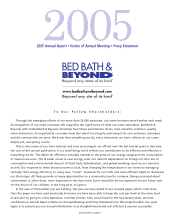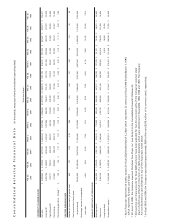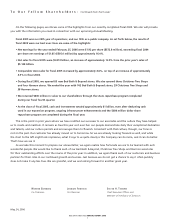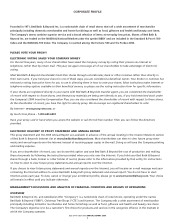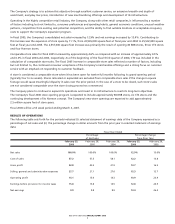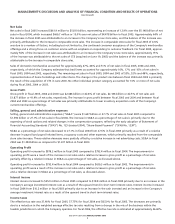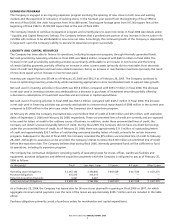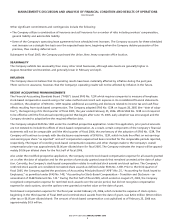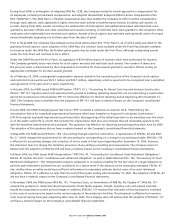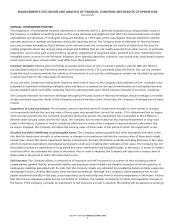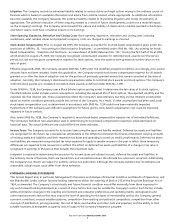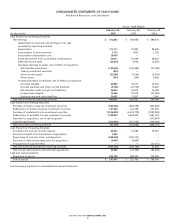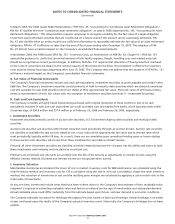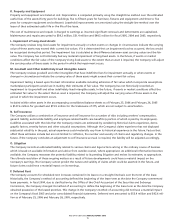Bed, Bath and Beyond 2005 Annual Report Download - page 10
Download and view the complete annual report
Please find page 10 of the 2005 Bed, Bath and Beyond annual report below. You can navigate through the pages in the report by either clicking on the pages listed below, or by using the keyword search tool below to find specific information within the annual report.
BED BATH& BEYOND ANNUAL REPORT 2005
8
CRITICAL ACCOUNTING POLICIES
The preparation of consolidated financial statements in conformity with U.S. generally accepted accounting principles requires
the Company to establish accounting policies and to make estimates and judgments that affect the reported amounts of assets
and liabilities and disclosure of contingent assets and liabilities as of the date of the consolidated financial statements and the
reported amounts of revenues and expenses during the reporting period. The Company bases its estimates on historical experi-
ence and on other assumptions that it believes to be relevant under the circumstances, the results of which form the basis for
making judgments about the carrying value of assets and liabilities that are not readily apparent from other sources. In particular,
judgment is used in areas such as the inventory valuation, impairment of long-lived assets, goodwill and other indefinitely lived
intangible assets, accruals for self insurance, litigation, store opening, expansion, relocation and closing costs, stock-based compen-
sation and income taxes. Actual results could differ from these estimates.
Inventory Valuation: Merchandise inventories are stated at the lower of cost or market. Inventory costs for BBB and Harmon
are calculated using the retail inventory method and inventory cost for CTS is calculated using the first-in, first-out cost method.
Under the retail inventory method, the valuation of inventories at cost and the resulting gross margins are calculated by applying
acost-to-retail ratio to the retail value of inventories.
At any one time, inventories include items that have been written down to the Company’s best estimate of their realizable value.
Judgment is required in estimating realizable value and factors considered are the age of merchandise and anticipated demand.
Actual realizable value could differ materially from this estimate based upon future customer demand or economic conditions.
The Company estimates its reserve for shrinkage throughout the year, based on historical shrinkage. Actual shrinkage is recorded
at year-end based upon the results of the Company’s physical inventory count. Historically, the Company’s shrinkage has not been
volatile.
Impairment of Long-Lived Assets: The Company reviews long-lived assets for impairment annually or when events or changes
in circumstances indicate the carrying value of these assets may exceed their current fair values. If it is determined that an impair-
ment loss has occurred, the loss would be recognized during that period. The impairment loss is calculated as the difference
between asset carrying values and the fair value. The Company has not historically had any material impairment of long-lived
assets. In the future, if events or market conditions affect the fair value of the Company’s long-lived assets to the extent that
an asset is impaired, the Company will adjust the carrying value of these assets in the period in which the impairment occurs.
Goodwill and Other Indefinitely Lived Intangible Assets: The Company reviews goodwill and other intangibles that have indefi-
nite lives for impairment annually or when events or changes in circumstances indicate the carrying value of these assets might
exceed their current fair values. Impairment testing is based upon the best information available including estimates of fair value
which incorporate assumptions marketplace participants would use in making their estimates of fair value. The Company has not
historically recorded an impairment to its goodwill and other indefinitely lived intangible assets. In the future, if events or market
conditions affect the estimated fair value to the extent that an asset is impaired, the Company will adjust the carrying value of
these assets in the period in which the impairment occurs.
Self Insurance: The Company utilizes a combination of insurance and self insurance for a number of risks including workers’
compensation, general liability, automobile liability and employee related health care benefits (a portion of which is paid by its
employees). Liabilities associated with the risks that the Company retains are estimated by considering historical claims experience,
demographic factors, severity factors and other actuarial assumptions. Although the Company’s claims experience has not dis-
played substantial volatility in the past, actual experience could materially varyfrom its historical experience in the future. Factors
that affect these estimates include but arenot limited to: inflation, the number and severity of claims and regulatory changes. In
the future, if the Company concludes an adjustment to self insurance accruals is required, the liability will be adjusted accordingly.
MANAGEMENT’S DISCUSSION AND ANALYSIS OF FINANCIAL CONDITION AND RESULTS OF OPERATIONS
(continued)

